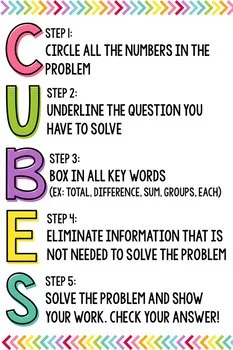The Math IEP Naughty List
A little over a year ago around holiday time I wrote a blog post called the PD Naughty List to outline some key items that professional development providers should never say, as these items strip away their credibility. I was presenting on Top Tips for Servicing Students with Disabilities in Mathematics for a virtual conference hosted by the Wabash Valley Education Center (WVEC) when I got the idea to do a Math IEP Naughty List! For several years I was the math intervention specialist in the sixth largest public school district in the United States. These ideas for the Math IEP Naughty List are born from reviewing countless IEPs and training and consulting on writing effective math IEP goals.
1 | Keywords
Here is a NON Example:
Given instructional level math word problems and a math keyword sheet, Anna will solve the problems using the keywords with 80% accuracy, by [date].
I wrote a blog post entirely on this topic called Keywords are NOT the Key. If you are not already familiar with the keyword strategy, it has been widely used in elementary school to help make the problems “easier.” Students are taught that each key word has a unique meaning - it is tied to a specific math operation. An example would be that every time you see “in all” you should add. This strategy unravels pretty quickly and students are left feeling like math is not logical and doesn’t make sense. In the original blog post I outline the 5 reasons why this strategy is so limited. The bottom line is that this strategy has been proven ineffective in general education so it most certainly should NOT be used with our most struggling students. If you need to have a problem solving goal, look at research and/or evidence based problem solving strategies such as the Three Reads instructional routine or TINS (Owen, 2003).
DO NOT use the ineffective keyword strategy in a goal.
DO use a research and/or evidence based problem solving strategy instead.
2 | Specific Programs
Here are 2 NON Examples:
Given a small group setting and math strategies (i.e.touchmath), Carol will fluently solve basic addition math facts with 80% accuracy in 4 out of 5 consecutive trials by [date].
Given a counting tool (touchmath points, abacus, cubes), Keondra will complete 20 two digit addition and subtraction problems with 80% accuracy for 6 consecutive weeks by [date].
While TouchMath is an appropriate Math intervention program for some students with disabilities, a specific program or it’s components should never be written into a goal. Keep in mind that an IEP is a legal document and follows the student to a new school, new district or even a new state. Instead of naming a program that may not be available if a student transfers, name a research and/or evidence based strategy. Strategies often do not require specialized training or a purchase in order to implement successfully.
DO NOT name a specific intervention program in a goal.
DO use a research and/or evidence based strategy instead.
3 | CUBES
Source: Just Add Glitter
Here is a NON Example:
Given grade level math word problems, a CUBES strategy chart (C-Circle the numbers, U-Underline the question, B-Box keywords, E-Eliminate extra information, S- Solve showing your work), and highlighters, Robert will determine the operation and strategy required to solve the problem and will solve correctly in 4 out 5 opportunities by [date].
You may have seen anchor charts in elementary school classrooms and colorful posters on Pinterest and Teachers Pay Teachers for this ineffective strategy. There is no research to back this one up, it’s just a fun acronym someone came up with and it caught on. Part of the problem with this is that it relies on the keyword strategy that we already debunked. Here ‘B’ stands for Box keywords. Robert Kaplinsky has a great blog post that addresses some of the concerns behind CUBES - Is Problem Solving Complex or Complicated? This post also offers up a replacement strategy - the Problem Solving Framework.
DO NOT use the CUBES strategy or any other tricks or shortcuts in a goal.
DO use a strategy that encourages students to make sense of the problem, which leads to long-term success with multi-step problems.
Key Takeaways
The Math IEP Naughty List includes 3 things you should NEVER include in your math IEP goals. What you did not see in this blog post are replacement goals. Why? Because the whole premise behind an Individualized Education Plan (IEP) is that it is designed for one student and must be a truly individualized document. There is not a one size fits all math word problem solving goal that will work for all students who struggle. It is vital to establish the priority educational need, then develop a goal that is aligned to the priority and best meets the needs of the student.
Another key point is the importance of staying on top of research in education. As strategies are proven to be ineffective or even detrimental to student learning, we need to remove them and replace them with proven strategies. If a strategy is proven ineffective for ALL students, then we have to be diligent in ensuring it does not make it into a legal document (IEP) for our students with disabilities.


